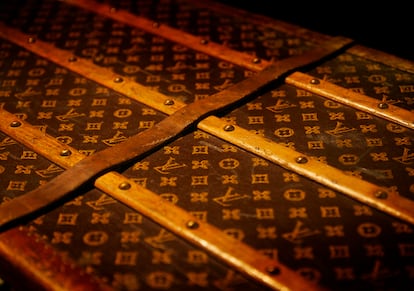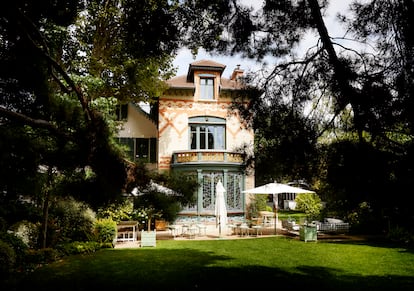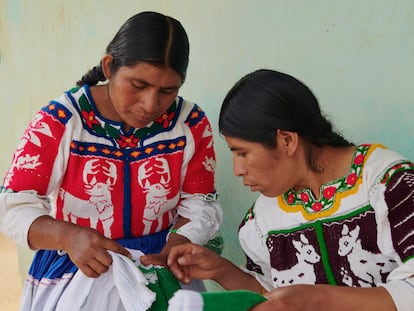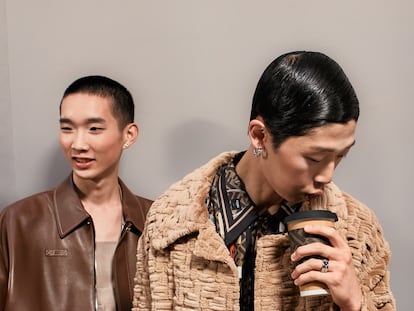The wealthy’s obsession with Louis Vuitton trunks: How they manufacture the most expensive suitcases in the world
In the Asnières workshop in Paris, they continue making the luxury firm’s signature item just as they have for 150 years: completely by hand. Its artisans cannot keep up with orders

Beyond Neuilly, one of the residential enclaves preferred by the moneyed Parisian bourgeoisie, sits Asnières-sur-Seine. On a quiet street of this elegant commune of Hauts-de-Seine, 40 minutes from the center of the capital, there is a house with cream-colored walls, a maroon roof and green shutters. Louis Vuitton, founder of the luxury empire that bears his name, lived here from 1859 until his death in 1892. Vuitton built the home just five years after creating his luggage brand. At the end of the 19th century, his only son, Georges, added on an art nouveau wing. The property is like one of the trunks that gave fame and fortune to the Vuitton family: a box of surprises, a cabinet of curiosities full of gems, sumptuous furniture and oriental vases.
But the biggest surprise of Asnières is not inside the house, but outside, or rather, where stands the original workshop designed by Monsieur Vuitton for the manufacture of his trunks and suitcases in the midst of the Industrial Revolution. The businessman chose this part of Paris for practical and commercial reasons. Asnières is close to the river, where the wood was transported, and close to a railway line with direct connection to the central Saint-Lazare station. The workshop, a building in the Eiffel style of glass and steel, diaphanous and luminous, continues to function as it has for 150 years. More than 250 artisans work in the 6,500 square meters of factory using the same tools they have for a century and a half: their hands.

Our guide in Asnières, whose identity cannot be revealed due to the confidentiality agreements of the company, explains to EL PAÍS that here they continue to do what has been done for a century and a half: trunks, only trunks. Louis Vuitton has formed part of LVMH, which has been one of Europe’s most valuable listed companies, since the end of the 1980s. Last year, the company recorded its highest net profits in history, €14 billion ($15.04 billion) In just the first half of the year, its net profits rose 30% and sales by another 15%. Its fashion and leather goods sector, and more specifically Vuitton, drove the rise in sales. The fashion house’s luggage division is a key part of the company, not just in economic terms but also for the brand’s image. Asnières is the sanctum of the fashion house, a showcase that allows them to show what their artisans are capable of making: exotic leather goods and highly complex custom orders for the most demanding clientele.
But, who buys trunks in the 21st century? Spanish chef Ferran Adrià, for example, uses them to protect his kitchen utensils while travelling. Asnières says there is a great and growing demand for trunks: indeed, they cannot keep up with orders. The workshop’s employees work in two shifts manufacturing some 4,000 pieces yearly. Even so, the waitlist varies between 12 and 18 months. These days, clients see the trunks more like objects of decoration than suitcases for travel. The company explains that they’re used as tables for living rooms or as night tables, as safes, jewelry boxes, or dressers.

At Asnières, they have manufactured and continue to manufacture suitcases to transport all kinds of things: watches, jewels, tennis racquets, umbrellas, bicycles, typewriters, books, golf clubs, champagne bottles, cocktail glasses and fine china… They also make dressing table-trunks, bed-trunks and desk-trunks. Everything they produce has already been sold and has an owner. They only work upon request. Each order requires between four months and a year of work and, normally, the artisan who begins a job is also who finishes it.
Asnières is a treasure chest, but it is also a safe deposit box. The perimeter is watched over by security guards and a closed-circuit television. The trunks are treated as jewels and cost just as much. This explains the secrecy and confidentiality policies regarding the workshop. The Cabine model, for example, created at the start of the 20th century to fit beneath beds in the cabins of transatlantic ocean liners, costs around €36,000 ($38,700). A trunk for athletic shoes can cost €180,000 ($194,000) and a curiosities cabinet designed by Marc Newson, around €250,000 ($268,000).

The super rich consider these pieces to be the ne plus ultra, the ultimate, and see in the initials LV a guarantee of luxury and exclusivity, although few know that those initials belonged to a humble country boy. Louis Vuitton was born in the hamlet of Anchay, in the Jura mountains, in the bosom of a family devoted to farming and carpentry. At 15 years of age, he left his home and went to Paris to work as a packer. At 17, he started his own packaging business. At that time, at the height of the railroad and steamboat boom, trucks had a curved lid so that rain would run off them. He began making them with a flat lid, which made them easier to stack, with a waterproof canvas and a lining that prevented the wood from swelling with moisture.
Louis Vuitton was not born as a luxury business, but as a business of functionality. It was Georges Vuitton, Louis’s son and the second generation at the helm of the company, who led the firm into the high-end world. At the time in which he took the reins, their clients would personalize luggage with their own name. He decided it would be better if they did it with his father’s. And so was born the canvas with the monogram of Vuitton, one of the first logos in the history of the fashion industry. The drawing, a flower inspired by the rose windows in Gothic churches, became the hallmark of the brand.

The monogram changed the history of the fashion house. Suddenly, the Vuitton trunks became unique, desirable and luxurious. Georges was also the architect of the theft-proof Tumbler lock. The head of the house invited Harry Houdini to try to escape from one of its trunks. The illusionist did not accept the challenge. Today, the house continues to use the same lock. Each one of them is unique and linked with a single client.
The list of Vuitton trunk buyers goes back to the times of the Empress Eugénie de Montijo and the actress Sarah Bernhardt. The brand keeps this list in a safe deposit box. The most important clients can visit Asnières to see how their custom suitcases are made. The workshop has its own museum where they exhibit such gems as Paul Poiret’s 1911 trunk and another from 1927 that belonged to the Greek royal family. The oldest piece is a chest from the 14th century, from the private collection of the Vuitton family, decorated with a Gothic flower reminiscent to that of the brand’s logo. The most recent is the Sac Maison de Famille, a bag that Nicolas Ghesquière created for spring-summer 2023 that recreates the Vuitton house.
But this is not a theme park, a Disneyland Paris. It is a workshop. The sounds of the factory confirm this. In the carpentry zone the artisans work with three types of wood: poplar, light and elastic; beech, homogenous and easy to work with, and okoume, light and soft. In the leather goods area, there are up to 5,000 types of different leathers, including exotic skins like that of the python or the crocodile. Hamid, a professional locksmith, has been forging locks for 16 years. Alex, a carpenter, has been lining the suitcases for four decades. Everything that is made here passes through quality control. Any error, no matter how small, condemns the product to total destruction.

Georges Vuitton, the man who elevated his last name to a synonym of luxury, died in Asnières in 1936. His son, Gaston, also lived and died there. Patrick Vuitton, fourth generation in this saga and great-great-grandson of the founder, died only three years ago. Two of his sons work for the company. This is the only Parisian fashion house still operating in its original family home and with its fifth generation aboard. The Vuitton have not lived in Asnières since the 1980s, but the spirit of Louis still resides in the trunks that bear his initials.
Sign up for our weekly newsletter to get more English-language news coverage from EL PAÍS USA Edition
Tu suscripción se está usando en otro dispositivo
¿Quieres añadir otro usuario a tu suscripción?
Si continúas leyendo en este dispositivo, no se podrá leer en el otro.
FlechaTu suscripción se está usando en otro dispositivo y solo puedes acceder a EL PAÍS desde un dispositivo a la vez.
Si quieres compartir tu cuenta, cambia tu suscripción a la modalidad Premium, así podrás añadir otro usuario. Cada uno accederá con su propia cuenta de email, lo que os permitirá personalizar vuestra experiencia en EL PAÍS.
¿Tienes una suscripción de empresa? Accede aquí para contratar más cuentas.
En el caso de no saber quién está usando tu cuenta, te recomendamos cambiar tu contraseña aquí.
Si decides continuar compartiendo tu cuenta, este mensaje se mostrará en tu dispositivo y en el de la otra persona que está usando tu cuenta de forma indefinida, afectando a tu experiencia de lectura. Puedes consultar aquí los términos y condiciones de la suscripción digital.
More information
Archived In
Últimas noticias
Most viewed
- Sinaloa Cartel war is taking its toll on Los Chapitos
- Oona Chaplin: ‘I told James Cameron that I was living in a treehouse and starting a permaculture project with a friend’
- Reinhard Genzel, Nobel laureate in physics: ‘One-minute videos will never give you the truth’
- Why the price of coffee has skyrocketed: from Brazilian plantations to specialty coffee houses
- Silver prices are going crazy: This is what’s fueling the rally











































